

Boston Region Metropolitan Planning Organization 2023 Coordinated Public Transit—Human Services Transportation Plan
Project Manager
Betsy Harvey
Project Principal
Sarah Philbrick
Data Analysts
Stella Jordan
Erin Maguire
Graphics
Adriana Fratini
Ken Dumas
Cover Design
Adriana Fratini
Editor
David Davenport
The preparation of this document was supported
by MPO Combined Planning and §5303 Contract #118967
Central Transportation Planning Staff is
directed by the Boston Region Metropolitan
Planning Organization (MPO). The MPO is composed of
state and regional agencies and authorities, and
local governments.
For general inquiries, contact
Central Transportation Planning Staff 857.702.3700
State Transportation Building ctps@ctps.org
Ten Park Plaza, Suite 2150 ctps.org
Boston, Massachusetts 02116
The Boston Region Metropolitan Planning Organization (MPO) operates its programs, services, and activities in compliance with federal nondiscrimination laws including Title VI of the Civil Rights Act of 1964 (Title VI), the Civil Rights Restoration Act of 1987, and related statutes and regulations. Title VI prohibits discrimination in federally assisted programs and requires that no person in the United States of America shall, on the grounds of race, color, or national origin (including limited English proficiency), be excluded from participation in, denied the benefits of, or be otherwise subjected to discrimination under any program or activity that receives federal assistance. Related federal nondiscrimination laws administered by the Federal Highway Administration, Federal Transit Administration, or both, prohibit discrimination on the basis of age, sex, and disability. The Boston Region MPO considers these protected populations in its Title VI Programs, consistent with federal interpretation and administration. In addition, the Boston Region MPO provides meaningful access to its programs, services, and activities to individuals with limited English proficiency, in compliance with U.S. Department of Transportation policy and guidance on federal Executive Order 13166. The Boston Region MPO also complies with the Massachusetts Public Accommodation Law, M.G.L. c 272 sections 92a, 98, 98a, which prohibits making any distinction, discrimination, or restriction in admission to, or treatment in a place of public accommodation based on race, color, religious creed, national origin, sex, sexual orientation, disability, or ancestry. Likewise, the Boston Region MPO complies with the Governor's Executive Order 526, section 4, which requires that all programs, activities, and services provided, performed, licensed, chartered, funded, regulated, or contracted for by the state shall be conducted without unlawful discrimination based on race, color, age, gender, ethnicity, sexual orientation, gender identity or expression, religion, creed, ancestry, national origin, disability, veteran's status (including Vietnam-era veterans), or background. A complaint form and additional information can be obtained by contacting the MPO or at http://www.bostonmpo.org/mpo_non_discrimination. To request this information in a different language or in an accessible format, please contact Title VI Specialist By Telephone: For people with hearing or speaking difficulties, connect through the state MassRelay service:
For more information, including numbers for Spanish speakers, visit https://www.mass.gov/massrelay.
|
Abstract
The Coordinated Public Transit–Human Services Transportation Plan (Coordinated Plan) documents the Boston Region Metropolitan Planning Organization (MPO) area’s current transportation providers; unmet transportation needs for seniors (people ages 65 years old and older) and people with disabilities; strategies and actions to meet the unmet needs; and priorities for implementation. The primary purpose of the Coordinated Plan is to improve coordination among transit agencies and other transportation providers to better serve the transportation needs of seniors and people with disabilities. The Coordinated Plan accomplishes this by setting regional priorities for transportation investments and initiatives for human services and public transit coordination.
In addition, the Coordinated Plan guides organizations in the region to develop proposals that are eligible to receive funding from the Federal Transit Administration’s (FTA) Section 5310 program, Enhanced Mobility of Seniors and Individuals with Disabilities Program. This program provides capital and operations assistance for services that improve mobility for seniors and people with disabilities. In Massachusetts, the Massachusetts Department of Transportation manages the application process for the Section 5310 program, under the Community Transit Grant Program (CTGP). Per FTA guidance, the MPO’s Coordinated Plan is updated every four years in concert with the Long-Range Transportation Plan. Since this 2023 update is considered in effect at the beginning of fiscal year 2024, it can be used by CTGP applicants starting in the state fiscal year 2025 application cycle.
Executive Summary
The primary purpose of the Coordinated Public Transit–Human Services Transportation Plan (Coordinated Plan) is to improve coordination among transportation providers to better meet the transportation needs of seniors and people with disabilities. It guides applicants in the Boston region in developing their proposals for the Federal Transit Administration’s (FTA) Section 5310, Enhanced Mobility of Seniors and Individuals with Disabilities Program. In Massachusetts this program is known as the Community Transit Grant Program (CTGP). The CTGP provides funding for projects that meet the transportation needs of seniors and people with disabilities when existing transportation services are unavailable, insufficient, or inappropriate to meet these needs.
As the metropolitan planning organization (MPO) for the Boston area regional planning association, the Boston Region MPO develops the Coordinated Plan for the 97 municipalities within its region. Figure ES-1 shows the municipalities within the MPO region.
Figure ES-1
Municipalities in the Boston Region MPO
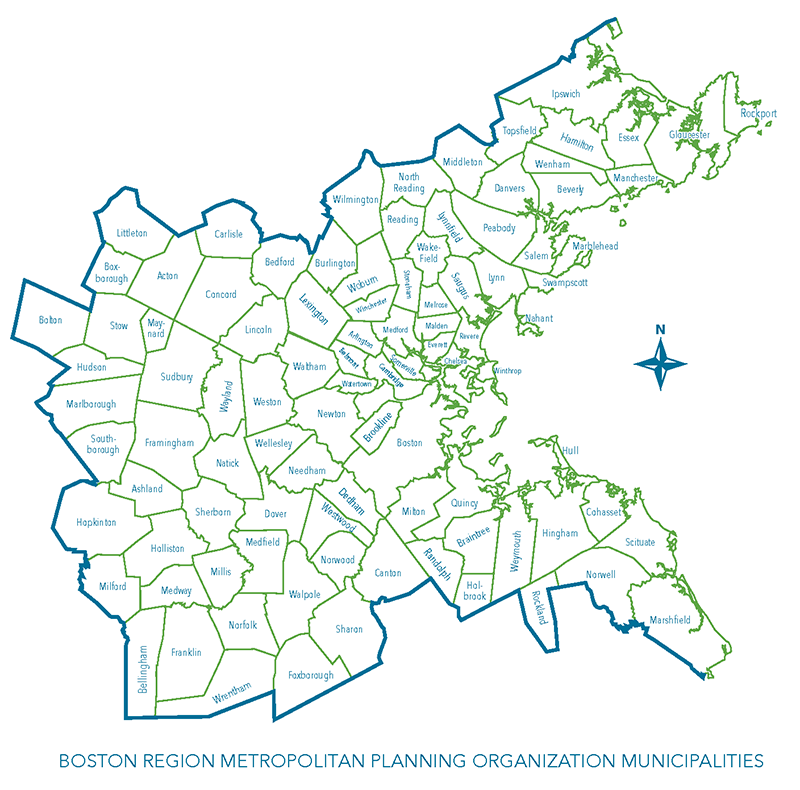
In Massachusetts, the state Department of Transportation manages the application process for the CTGP, which is a competitive grant program with an annual application process. Organizations eligible to apply for CTGP funding include local government, private nonprofit organizations, and public transit operators—the Massachusetts Department of Transportation may also use 5310 funding to administer and implement state-prioritized projects. This 2023 update to the Coordinated Plan replaces the MPO’s 2019 Coordinated Plan and should be referred to in CTGP applications beginning with the state fiscal year 2025 application cycle.
To be considered for CTGP funding, projects located within the MPO region must address a transportation need, strategy, or action identified in chapter four of this Coordinated Plan. Table ES-2 (Table 4-2 in chapter 4 in the main document) lists the human service transit needs for the region, as well as strategies and actions to meet those needs; a proposed project that addresses the needs, strategies, or actions that would be considered “included” in the Coordinated Plan. Given the large and diverse nature of the Boston region, the transportation needs, strategies, and actions described in this Coordinated Plan are broad in order to elicit a range of project proposals that are likely to address unmet human service transportation needs.
Projects eligible for the CTGP include both traditional capital projects and nontraditional projects. Traditional capital projects include the purchase or lease of vehicles for human service transportation that are carried out to meet the special transportation needs of seniors and people with disabilities when public transit is insufficient, inappropriate, or unavailable, as well as support facilities like benches and shelters. Nontraditional projects can include volunteer driver programs, wayfinding, and travel training, among others.
There are a wide variety of public transit services in the Boston region, which can be explored in more detail in this interactive web map. These include
Public transit—both human service transportation and transit that serves the general population—in the Boston region can often be disconnected, especially outside of the immediate Boston area. Services are run by many different transit providers, with their own fares, eligibility requirements, and service areas. These may or may not be coordinated with other providers with adjacent services, sometimes leading to long wait times, high fares, or simply the inability to reach a particular part of the region at all by public transit. These challenges are magnified in towns further from Boston, as the public transit network is more limited in these areas, despite the often many seniors and people with disabilities who live there. Improved coordination of services and closing the gaps in existing services, through funding such as the CTGP, is critical for addressing the unmet human service transportation needs in the Boston region.
Understanding current and future demographics of seniors and people with disabilities helps identify gaps in services and communities where transportation needs may be highest. In the Boston MPO Region, 16 percent of people are 65 or older, while 10 percent have a disability. There is significant overlap between these populations: nearly 50 percent of seniors have a disability. These populations are expected to increase in the coming decades—demographic projections from the Metropolitan Area Planning Council and the University of Massachusetts Donahue Institute suggest that by 2050, about 20 percent of the population will be aged 65 or older. This is a 37 percent increase over the 2020 population, compared to a 10 percent increase for the total population in the MPO region. While demographic projections for people with disabilities are not available, it is reasonable to assume that this population will increase as the senior population does so.
To help identify unmet human service transportation needs, MPO staff conducted extensive public engagement to get input from seniors and people with disabilities, people who work with these populations, and human service transportation providers. Staff used this input to then develop strategies and actions that transportation providers in the region could undertake to address these needs and identified those that might be priorities for the Boston region.
Public engagement was conducted concurrently with engagement for the development of the MPO’s 2023 Long-Range Transportation Plan (LRTP), Destination 2050, during which staff collected input about transportation needs and priorities in the region. Most engagement activities during the development of the LRTP and the Coordinated Plan between 2019 and 2023 were conducted virtually due to the COVID-19 pandemic.
Staff also conducted several engagement activities focused directly on the Coordinated Plan to collect input. These included meetings with Regional Coordinating Councils; discussions focused on human service transportation needs with the MPO’s Transit Working Group and Advisory Council; a human service transportation coordination workshop with councils on aging, disability commissions, and transit providers; and a survey about human service transportation needs.
The survey—which was distributed to organizations that work with seniors and people with disabilities, human service transportation providers, and the general public, with a focus on getting input from these populations—was conducted in spring of 2023. Respondents were asked to identify their top human service transportation needs and select the top strategies that would help meet those needs. This was asked across four categories: infrastructure, public transit, coordination, and education improvements. The four most commonly selected strategies were
Respondents were then asked to rank their selected strategies from highest to lowest priority. The two most frequently selected strategies from each category are shown in Figure ES-2—the darkest blue indicates when a strategy was most frequently ranked in that category.
Figure ES-2
Ranking of Strategies to Improve Human Services Transportation

ADA = Americans with Disabilities Act.
Transportation needs and strategies and actions to address them that were identified through public engagement were grouped into the following topic areas:
Table ES-1 shows the needs, strategies, actions, and resources to support them by topic area.
Table ES-1
Unmet Human Service Transportation Needs and Strategies for Improvement
ADA = Americans with Disabilities Act. COA = councils on aging. LEP = limited English proficiency. RTA = regional transit agency. TNC = transportation network company.
1 While funding of benches and shelters are allowed under federal 5310 guidelines, as a practice, it is not part of the state Community Transit Grant Program. Other funding opportunities that may support these are listed in table 4-3 or may seek support from their regional transit authority.
While this Coordinated Plan does not attempt to dictate which strategies and actions should receive funding, it does describe priorities for the Boston region based on how frequently needs were identified during the public engagement process to support the development of applications for CTGP. More than one-half of all comments received spoke of transportation service improvements, with the next most common topic areas infrastructure improvements and inter-agency coordination. Some of the key takeaways from this input include
This Coordinated Plan updates and replaces the Boston Region MPO’s 2019 Coordinated Plan starting with the state fiscal year 2025 CTGP grant cycle. This document will be updated again in four years in concert with the Boston MPO’s next planned LRTP update, per federal guidance.
Chapter 1—About the Coordinated Plan
The primary purpose of the Coordinated Public Transit–Human Services Transportation Plan (Coordinated Plan) is to improve coordination among Boston region transportation providers to better meet the transportation needs of seniors and people with disabilities. It guides applicants in the Boston region in developing their proposals for the Federal Transit Administration’s (FTA) Section 5310, Enhanced Mobility of Seniors and Individuals with Disabilities Program. In Massachusetts this program is known as the Community Transit Grant Program (CTGP).
The CTGP provides funding for projects that meet the transportation needs of seniors and people with disabilities when existing transportation services are unavailable, insufficient, or inappropriate to meet these needs. In Massachusetts, the Department of Transportation manages the application process for the CTGP, which is a competitive grant program with an annual application process. Organizations eligible to apply for CTGP funding include states, local government, private nonprofit organizations, and public transit operators.
For Boston area projects to be considered for CTGP funding, they must address a transportation need, strategy, or action identified in chapter four of this Coordinated Plan. Table 4-2 (in chapter 4) lists the human service transportation needs for the region, as well as strategies and actions to meet those needs; a proposed project that addresses any of the needs, strategies, and actions identified in that table would be considered to be “included” in the Coordinated Plan. Given the large and diverse nature of the Boston region, the transportation needs, strategies, and actions described in this Coordinated Plan are broad in order to elicit a range of project proposals that are likely to improve unmet human service transportation needs. This 2023 update to the Coordinated Plan replaces the MPO’s 2019 Coordinated Plan and should be referred to in CTGP applications beginning with the state fiscal year 2025 application cycle.
In Massachusetts, the MPOs are responsible for developing the Coordinated Plan for their region. The Boston Region MPO develops the Coordinated Plan for the 97 municipalities within its region. Figure 1-1 shows the municipalities within the MPO region.
Figure 1-1
Municipalities in the Boston Region MPO

Projects eligible for the CTGP include both traditional capital projects and nontraditional projects. The FTA defines traditional capital projects as those planned, designed, and carried out to meet the special transportation needs of seniors and people with disabilities when public transit is insufficient, inappropriate, or unavailable. Nontraditional projects are those that exceed transportation services required under the Americans with Disabilities Act (ADA); improve access to fixed-route service and decrease reliance on ADA-complementary paratransit service by people with disabilities; or provide alternatives to public transit that assists seniors and people with disabilities with transportation.
FTA guidance provides some examples of eligible traditional and nontraditional projects:
In keeping with FTA guidance, this Coordinated Plan includes the following components:
Chapter 2—Existing Transportation Services
This chapter describes the transportation services that operate in the Boston region. An online map of these services can be found here.
The MBTA is the primary transit provider in the Boston region. It directly operates or hires contractors to operate heavy rail, rapid transit, light rail, bus rapid transit, local and express bus, ferry, and paratransit services.
The MBTA rapid transit system serves 125 stations on four lines: the Red Line (including the Mattapan Trolley), the Orange Line, the Blue Line, and the Green Lines.
The Mattapan Trolley is an extension of the Red Line and connects Ashmont Station with stations through Dorchester and a portion of the town of Milton, with the terminus in the Mattapan neighborhood of Boston. Seven of the line’s eight stations are accessible.
Several accessibility projects are in progress. On the Green Line, accessibility improvements are being made to Hynes, Newton Highlands, and Symphony Stations.
The Silver Line (SL) consists of five bus rapid transit routes. SL1 serves downtown Boston, the Seaport, and Boston Logan International Airport. SL2 connects South Station and the Seaport. SL3 connects South Station to the Airport, East Boston, and Chelsea. SL4 and SL5 both serve downtown Boston, the South End, and Roxbury. MBTA is currently exploring Silver Line extension alternatives that would extend SL3 service to Everett, Kendall Square, and North Station.
The MBTA has more than 145 bus routes and extends from Boston to just beyond Interstate 95. Three municipalities that are served by MBTA buses are not in the MPO region—Avon, Billerica, and Brockton. Forty-seven municipalities are in the MPO region but are not served by MBTA buses—many are served instead by other regional transit authorities. All MBTA buses are accessible. Close to the urban core, buses provide crosstown service and feeder service to rapid transit stations. Buses operating outside of the urban core provide local service, feeder service to rapid transit and some commuter rail branches, and express service to Boston.
The MBTA is redesigning its bus network through the Bus Network Redesign process. The project is currently in its planning phase, and many bus routes are expected to change as the project is implemented in the coming years.
The MBTA’s commuter rail system extends beyond the MPO’s boundary. It consists of 12 radial lines, which serve municipalities in Massachusetts and Rhode Island. There is also seasonal service to Foxborough for special events, to Wachusett Mountain via the Fitchburg Line in the winter, and weekend service to Hyannis on the Middleborough/Lakeville Line during the summer. Forty-nine municipalities in the MPO region have a commuter rail station. There are 141 commuter rail stations, 111 of which are accessible. Several accessibility improvements are under construction, including Auburndale, West Newton, Newtonville, Lynn, Natick Center, South Attleboro, Winchester Center, and Worcester Union stations. South Coast Rail Phase 1 is currently under construction and is expected to be completed in late 2023—it will connect Fall River, Taunton, and New Bedford to Boston.
Ferry services link downtown Boston to Charlestown, East Boston, Quincy, Logan Airport, Lynn, Winthrop, Hingham, and Hull. The East Boston ferry is currently a seasonal pilot service. The Lynn ferry service is seasonal as well.
The RIDE is MBTA’s door-to-door, shared-ride, paratransit service for people who have a disability that prevents them from using the agency’s fixed-route services. The RIDE is an advance-request service that operates vans and sedans in 58 municipalities, generally between 5:00 AM and 1:00 AM. The MBTA also offers The RIDE Flex, which is provided by Uber and Lyft. This program provides more flexible booking options, including same-day trips.
CATA serves the towns of Gloucester and Rockport, and provides additional service to Danvers, Essex, and Ipswich. CATA’s fixed-route service consists of nine routes. CATA’s dial-a-ride service provides door-to-door transportation for people 60 years of age and older and adults who have a disability. This service is available in Gloucester and Rockport, and for organized trips outside of the Cape Ann region. CATA service operates entirely within the MPO region.
GATRA operates fixed-route service in Attleboro, Taunton, Bellingham, Berkley, Carver, Dighton, Duxbury, Foxborough, Franklin, Hanover, Kingston, Lakeville, Mansfield, Marshfield, Medway, Middleborough, Norfolk, North Attleboro, Norton, Pembroke, Plainville, Plymouth, Plympton, Raynham, Rehoboth, Scituate, Seekonk, Wareham, and Wrentham. Bellingham, Foxborough, Medway, Marshfield, Norfolk, Scituate, Wareham, and Wrentham are in the MPO region. The agency operates 35 routes (not including route variations). GATRA provides dial-a-ride service for people with disabilities, and for seniors ages 60 years and older.
MWRTA operates 17 fixed-route services, five commuter shuttles, and CatchConnect, an on-demand micro-transit service in Wellesley, Hudson, and Framingham/Natick. It also provides demand response services for seniors and people with disabilities, which includes American with Disabilities Act (ADA) paratransit service, in Framingham, Natick, Wellesley, and Dover. MWRTA serves the municipalities of Ashland, Dover, Framingham, Holliston, Hopedale, Hopkinton, Hudson, Marlborough, Milford, Natick, Sherborn, Southborough, Sudbury, Wayland, Wellesley, and Weston.
MART provides public transportation to 24 municipalities in north-central Massachusetts; included in those municipalities are Stow, Bolton, Boxborough, and Littleton, which are also within the MPO region. It operates 13 local bus routes, five regional bus routes, and shuttles that provide connections to Boston, Worcester, and on-demand to Devens. ADA-eligible paratransit service is available in the same area served by fixed-route service. MART also provides councils on aging (COA) services in all its member communities.
BAT provides service to the South Shore and Greater Brockton area. Of the 11 municipalities that are served by BAT, one is in the MPO region (Rockland). BAT also runs a fixed-route bus service from Brockton to Ashmont Station on the Red Line.
LRTA serves 19 routes in 14 municipalities, three of which are in the MPO region—Acton, Maynard, and Carlisle. LRTA also provides curb-to-curb ADA paratransit service to people with disabilities and to seniors within the LRTA service area who are 60 years of age or older.
MVRTA serves 13 municipalities. Although none of them are in the Boston region, it does provide medical transportation from the MVRTA services area to the Lahey Clinic in Peabody and Boston medical facilities.
Massport operates several transit services to the port and airport facilities that the agency operates. Within the Boston region, these include the following services:
A TMA is a membership-based coalition of businesses, universities and other institutions, and municipalities that work together to provide transportation solutions for commuters. The transit services listed below are funded by each TMA and provide transportation for employees of the TMA membership and sometimes for members of the public. Only TMAs that provide their own transit services are listed below.
The Alewife TMA serves the area around Alewife Station in Cambridge. The TMA operates two shuttles—the Alewife Station Loop Shuttle, which connects area businesses and residences with Alewife Station and a shuttle between Alewife Station and The Royal Belmont and Discovery Park.
The Charles River TMA serves Cambridge-area residents and businesses. The TMA operates the EZRide Shuttle, which connects North Station to the Cambridgeport and Kendall Square neighborhoods in Cambridge.
CTC serves the municipalities of Westford, Littleton, Acton, Concord, Maynard, Sudbury, and Westford. CTC provides the following transit services:
Longwood Collective serves medical and science-related businesses and their employees in the Longwood Medical Area (LMA) of Boston. Longwood Collective operates seven shuttles that serve employees who work in the LMA. Most require passengers to be employees of Longwood Collective member institutions. Two are park-and-ride shuttles (Fenway and Renaissance Garage), three connect to transit stations (JFK/UMass Station, Midday and Evening Ruggles-JFK combo, and Ruggles Station), and two operate between employers (Landmark and M2 Cambridge-Boston).
Middlesex 3 TMA serves nine municipalities; Lexington, Bedford, and Burlington are within the Boston MPO region. One shuttle provides reverse-commute commuter service from Alewife and Haymarket stations with employers in Bedford and Billerica.
The Neponset Valley TMA serves the municipalities of Canton, Dedham, Foxborough, Norwood, and Westwood. It operates the following services:
The Route 128 Business Council provides employee shuttles for member businesses. They serve municipalities along the Route 128 corridor. Seven shuttles connect businesses with the Alewife Station on the Red Line, two shuttles connect residents with Waltham Center, and one shuttle connects Needham Crossing to the Newton Highlands Station on the Green Line.
Watertown TMA operates two shuttles, the WATConnector—Arsenal Street, which connects Harvard Square Station on the Red Line to employers in Watertown, and WATConnector—Pleasant Street, which connects Watertown Square and Harvard Square.
Some nonprofit organizations and local private institutions, such as universities and hospitals, also operate transit services in the region. They typically operate shuttles specifically for their employees and/or patients or students between their various campuses and/or nearby neighborhoods. Smaller services also provide local transportation for seniors or people with disabilities. Private for-profit senior care companies and taxi companies may also provide transportation around the region. While these are too numerous to list here, http://www.massridematch.org provides information about these and other transportation providers.
Many private, for-profit transit operators serve the Boston region. The following carriers make stops in the Boston region:
Many municipalities offer transportation services for seniors and/or people with disabilities. Municipal COAs provide support services to seniors, families, and caregivers, and some offer transportation services for these populations. The Massachusetts COA maintains an online COA directory. Some municipalities and/or RTAs also offer non-age restricted shuttle services, such as those funded through the MPO’s Community Connections Program. These include
Some COAs and nonprofit human service organizations also operate volunteer driver programs, such as those listed below.
Public transit in the Boston region—both human service transportation and transit that serves the general population—is run by many different providers and because of that can often be fragmented, especially outside of the immediate Boston area. Each transit provider has its own fares, eligibility requirements, and service areas. These may or may not be coordinated with other providers with adjacent services, sometimes leading to long wait times, high fares, or simply the inability to reach a particular part of the region at all by public transit. These challenges are magnified in towns further from Boston, as the public transit network is more limited in these areas, despite the many seniors and people with disabilities who live in these areas.
Meanwhile, since the 2019 Coordinated Plan, the COVID-19 pandemic has affected transit services throughout the region. Some services, such as volunteer programs, were suspended, while others, such as some fixed-r services, were reduced. Ridership on many services has yet to bounce back to pre-pandemic levels, and many transit providers are struggling to make up for the lost income.
Improved coordination of services between providers and closing the gaps in existing services, through funding such as the CTGP, is a critical strategy for both reducing costs by resource sharing between providers and reducing route duplication, and for addressing the many challenges riders face due to a fragmented transit network. This will be increasingly important as the population ages over the coming years, which is described in the next chapter. The CTGP is one resource to help transit providers improve coordination; chapter four describes strategies to meet these and other human service transportation challenges, as well as other resources to support human service transportation in the Boston region.
Chapter 3—Demographic Analyses
This chapter provides demographic data about seniors and people with disabilities in the Boston region using data from the US Census Bureau, as well demographic projections developed by the University of Massachusetts (UMass) Donahue Institute and the Metropolitan Area Planning Council (MAPC).
Federal Transit Administration (FTA) guidance for the 5310 Program defines a senior as an individual who is 65 years old or older. In the Boston region, 546,334 people are seniors, about 16 percent of the population. Figure 3-1 shows the population ages 65 years and older, by municipality. Essex has the fewest number of seniors, while Boston has the most. Figure 3-2 shows the percent of the population in each municipality who are seniors. Rockport has the most with 35.2 percent and Somerville has the least with 9.9 percent.
Figure 3-1
Population Ages 65 and Older, by Municipality

Figure 3-2
Percent of the Population Ages 65 and Older, by Municipality
For Placement Only.

In the Boston Region, about 337,688 people, or 10 percent of the population, reported having a disability on the 2017–21 American Community Survey.1 Figure 3-3 shows the estimated number of people in each municipality who report having a disability. Sherborn has the fewest number of people with disabilities and Boston has the most. Sherborn also has the lowest percentage, with three percent, while Lynn and Peabody have the highest, with 15 percent. Figure 3-4 shows the percent of the population in each municipality that has a disability.
Figure 3-3
Population with Disabilities, by Municipality
For Placement Only.
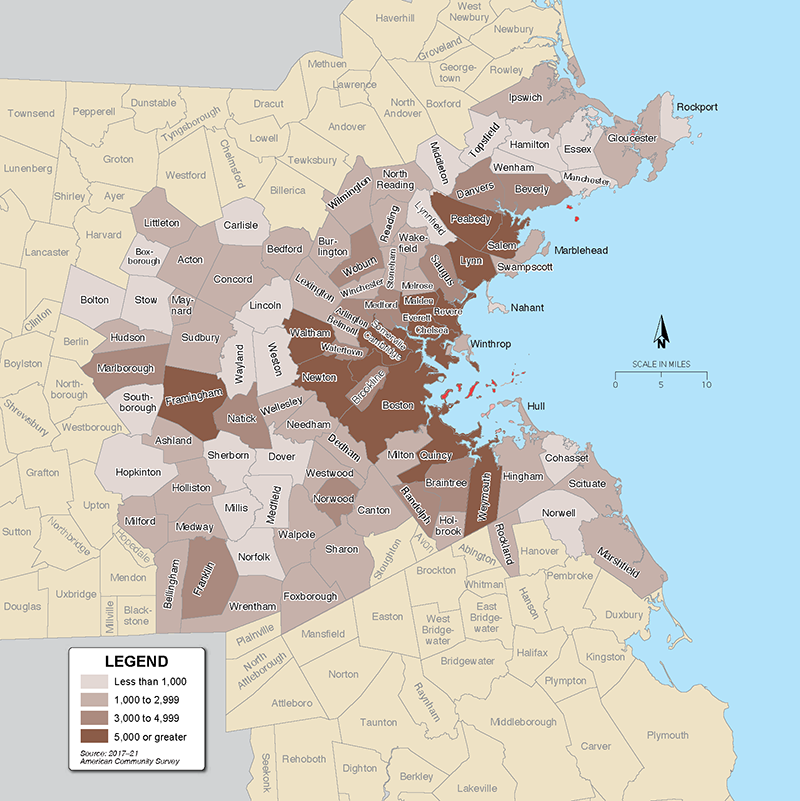
Figure 3-4
Percent of the Population with Disabilities, by Municipality
For Placement Only.
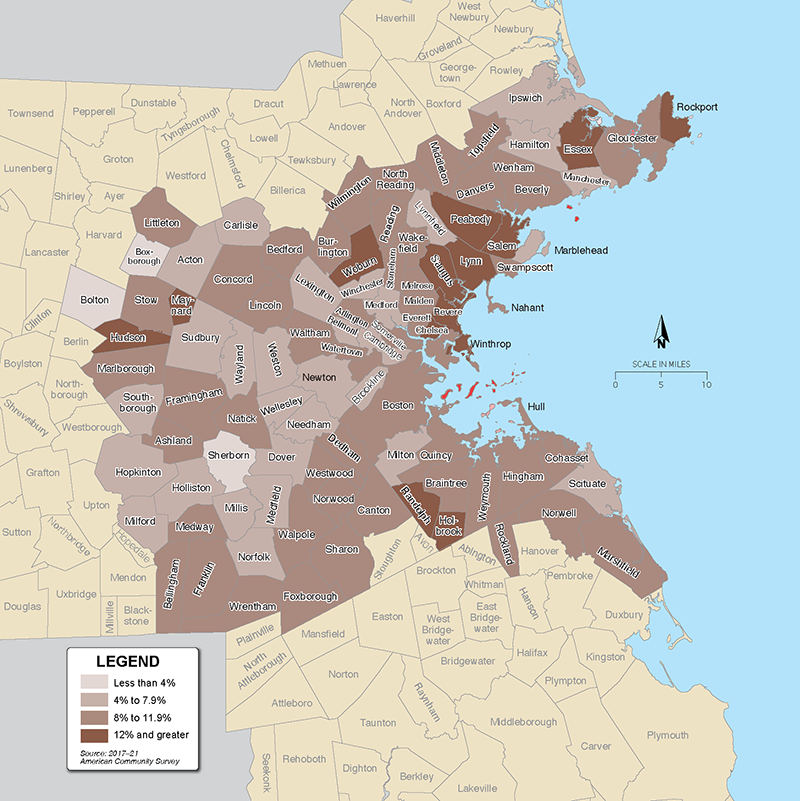
Seniors in the Boston region are more likely than the rest of the population to have a disability. About 45 percent of seniors have a disability, the highest of any age cohort. Table 3-1 shows the MPO population with disabilities broken out by age cohort.
Table 3-1
Boston Region MPO Population with Disabilities by Age Cohort
For Placement Only.
| Under 5 Years | Ages 5 to 17 | Ages 18 to 34 | Ages 35 to 64 | Ages 65 and Older | Boston Region | |
|---|---|---|---|---|---|---|
| Percent | 0.5% | 7.7% | 13.8% | 32.6% | 45.4% | 10.1% |
| Population Estimate | 1,592 | 25,882 | 46,706 | 110,012 | 153,496 | 337,688 |
* Disability status is determined for the noninstitutionalized population.
MPO = metropolitan planning organization.
Source: 2017–21 American Community Survey and 2020 Decennial Census.
Demographic projections completed for Destination 2050, the MPO’s Long-Range Transportation Plan (LRTP) by the UMass Donahue Institute and MAPC, show that the percentage of the population 65 years and older is projected to increase about 37 percent between 2020 and 2050. That compares with about nine percent for the population overall. Figure 3-5 shows the projected change in population for each age cohort.
Figure 3-5
Population Projections by Age Cohort, 2020 through 2050

Source: University of Massachusetts Donahue Institute and the Metropolitan Area Planning Council.
Demographic projections are not available for people with disabilities. However, as shown in Table 3-1, nearly one-half of seniors have a disability. With a projected increase in the percent of the population in this age cohort, the share of the population with disabilities will likely increase as well. These data suggest that human service transportation must continue to expand in the Boston region and address existing gaps and needs to meet the demand of the region’s aging population.
Throughout the development of the Coordinated Plan, Metropolitan Planning Organization (MPO) staff engaged stakeholders and members of the public, including seniors and people with disabilities, nonprofit human service organizations, and transportation providers, to gather feedback about the transportation needs of seniors and people with disabilities and discuss potential strategies to address those needs. This chapter describes the public engagement activities conducted and the key findings that led to the identification of unmet needs, strategies, and priorities for mobility improvements for seniors and people with disabilities in the Boston region.
Public engagement was conducted concurrently with engagement for the development of the MPO’s 2023 Long-Range Transportation Plan (LRTP), Destination 2050, during which staff collected input about transportation needs and priorities in the region. Most engagement activities during the development of the LRTP and the Coordinated Plan between 2019 and 2023 were conducted virtually due to the COVID-19 pandemic.2 This included meetings with subregional councils that are coordinated by the Metropolitan Area Planning Council (MAPC) that bring interested parties together to discuss planning issues in their subregion;3 meetings of the MPO’s Transit Working Group4 and Regional Transportation Advisory Council (Advisory Council),5 independent forums that bring together varied perspectives on transportation from throughout the region to inform the MPO’s work; and scenario planning focus groups with stakeholders representing advocacy and community-based organizations as well as academic and business institutions.6 Staff also conducted several surveys during the development of the LRTP and Coordinated Plan, including a visioning survey that assessed public priorities for the future of the region’s transportation system.
Staff also conducted several engagement activities focused directly on the Coordinated Plan, seeking additional perspectives from seniors and people with disabilities, and transit providers and institutions who serve them. Staff visited several Regional Coordinating Councils’ (RCC) meetings during the development of the Coordinated Plan, including meetings of the Boston North RCC, the Blue Hills RCC, and the Neponset Valley RCC. 7 Staff also held discussions focused specifically on the Coordinated Plan and human services transportation needs with the Transit Working Group and the Advisory Council, and hosted a human services transportation coordination workshop with municipal Councils on Aging (COA), Disability Commissions, and other transit providers, with breakout sessions that focused on various coordination topics and transportation challenges specific to different geographic regions within the MPO area.
To supplement these targeted engagement activities and gather a broader range of input from members of the public, staff also deployed a survey that asked about transportation needs, and strategies to meet those needs, for seniors and people with disabilities, with several questions focused on which strategies to prioritize. The survey was distributed broadly through the MPO’s email and social media channels, and partner organizations distributed it to their contacts.8
In addition to the survey, staff received 293 comments related to human services transportation throughout the public engagement process. Table 4-1 provides a comprehensive list of engagement activities and input sources that informed the development of the Coordinated Plan.
Table 4-1
Coordinated Plan Feedback Sources
Feedback Source |
Engagement Focus |
Time |
Human Services Transportation survey |
Coordinated Plan |
Spring–Summer 2023 |
Human Services Transportation Coordination Workshop |
Coordinated Plan |
April 2023 |
RCC meetings |
Coordinated Plan |
Summer 2022 and 2023 |
Transit Working Group Coffee Chats |
Coordinated Plan |
October 2021 and November 2022 |
Regional Advisory Council meetings |
Coordinated Plan; general human services transportation coordination |
January 2023 and June 2023 |
MAPC subregional group meetings |
LRTP Needs Assessment; TIP; and other MPO programs and projects |
Fall 2020, 2021, and 2022 |
Other Transit Working Group meetings |
General transit service issues and priorities |
2021–22 |
Other RCC meetings |
General transit service and transportation issues and priorities |
2021–22 |
UPWP study idea surveys |
UPWP |
2020–23 |
TIP criteria update engagement |
TIP |
2019 |
Big Ideas for Scenario Planning focus groups |
LRTP |
2021 |
Destination 2050 visioning survey |
LRTP |
2022–23 |
Community Health Needs Assessments from regional medical institutions |
Coordinated Plan |
2019–23 |
LRTP = Long-Range Transportation Plan. MAPC = Metropolitan Area Planning Council. RCC = Regional Coordinating Council. TIP = Transportation Improvement Program. UPWP = Unified Planning Work Program.
In spring of 2023, MPO staff conducted a survey to better understand the transportation needs of seniors and people with disabilities and to identify strategies and actions that could address these needs. (See Appendix A for the survey questionnaire.) Staff received more than 300 responses.
Most survey responses came from the general public. Figure 4-1 shows the affiliation of survey respondents. Approximately 47 percent of the respondents were members of the general public, followed by 17 percent affiliated with a COA, and 11 percent affiliated with another form of municipal government.
Figure 4-1
Affiliation of Survey Respondents

Approximately 31 percent of respondents self-identified as having a disability, while 44 percent of respondents said they are 65 years of age or older. Both response rates are greater than the MPO region population average of 10 and 16 percent, respectively.
Twenty percent of respondents said they identify as a race or ethnicity other than white. Women accounted for 63 percent of survey respondents, while men represented 25 percent, non-binary people represented one percent of respondents, and 12 percent of respondents chose not to answer. Furthermore, approximately eight percent of respondents indicated having an income level that falls below the MPO’s low-income threshold.
Survey respondents were asked to select two strategies that would improve mobility most effectively from four categories: infrastructure, public transit, coordination, and education improvements. Figures 4-2 through 4-5 show the distribution of respondents’ selections in each of the four categories. The size of each box in the figures represents the number of times it was selected as a strategy to prioritize by survey respondents.
2 Collectively, this input was gathered into a Needs Assessment. The Needs Assessment was used to develop goals and objectives for the MPO that help guide the prioritization of MPO investments, as well as investment programs that lay out the types of projects that the MPO will fund.
3 There are eight subregions within MAPC. A map of these subregions can be found at mapc.org/get-involved/subregions/.
4 The MPO convened the Transit Working Group to help improve coordination among transit providers in the region and inform MPO activities and decisions. Participants include regional transit authorities, transportation management associations, municipalities that operate transit services, and state transportation agencies. More information about the Transit Working Group can be found at bostonmpo.org/transit-working-group.
5 The Regional Transportation Advisory Council is an independent body that brings public viewpoints and advice on transportation planning to the MPO. Membership includes municipalities, professional organizations, and transportation advocacy groups. More information about the Advisory Council can be found at bostonmpo.org/rtac.
6 In 2021, staff held a series of focus groups involving more than 40 organizations and entities in the Boston region to identify driving forces that will shape transportation in the region and strategies to respond to future conditions. The engagement process and results are documented in the Big Ideas StoryMap: https://arcg.is/uzKbD.
7 RCCs are voluntary coalitions of transportation providers, human service organizations, advocates, and planners who collaborate to identify and address regional community transportation needs. Each RCC provides an open forum for the exchange of information and sets its own priorities based on member interests and regional needs. More information about RCCs can be found at mass.gov/service-details/regional-coordinating-councils-for-community-transportation.
8 These partner organizations included the RCCs, Massachusetts Councils on Aging, and MAPC.
Figure 4-2
Priorities for Infrastructure Improvements
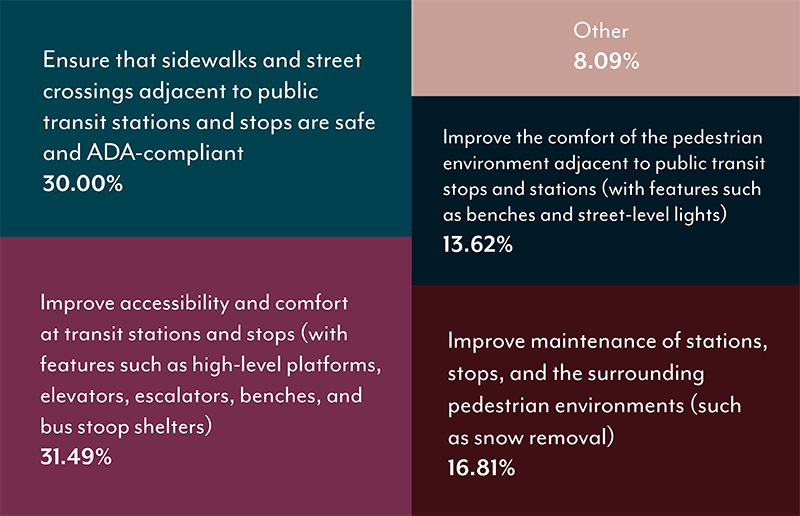
Figure 4-3
Priorities for Public Transit Improvements
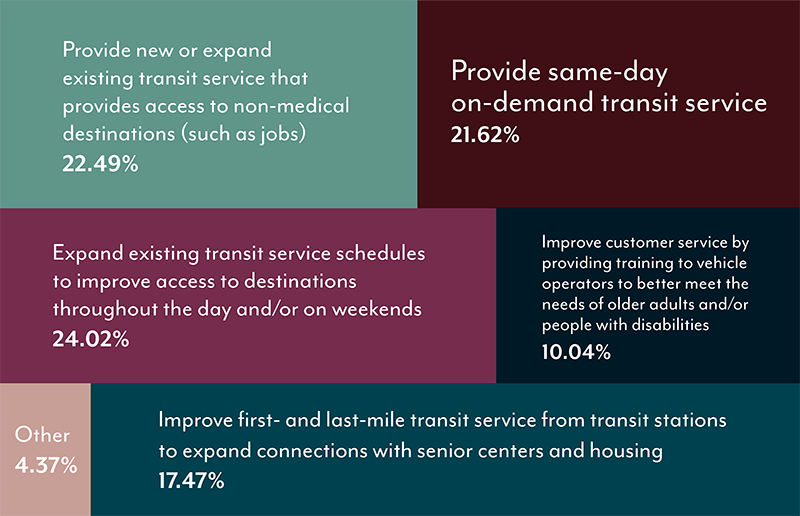
Figure 4-4
Priorities for Coordination Improvements
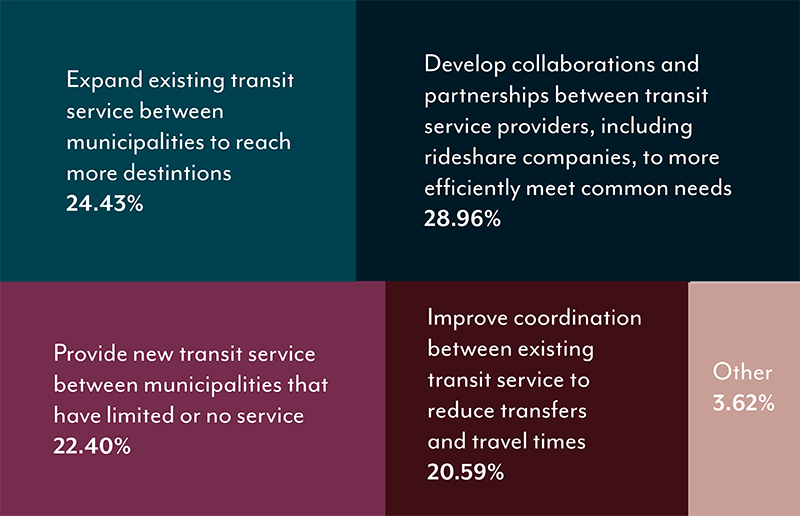
Figure 4-5
Priorities for Education Improvements
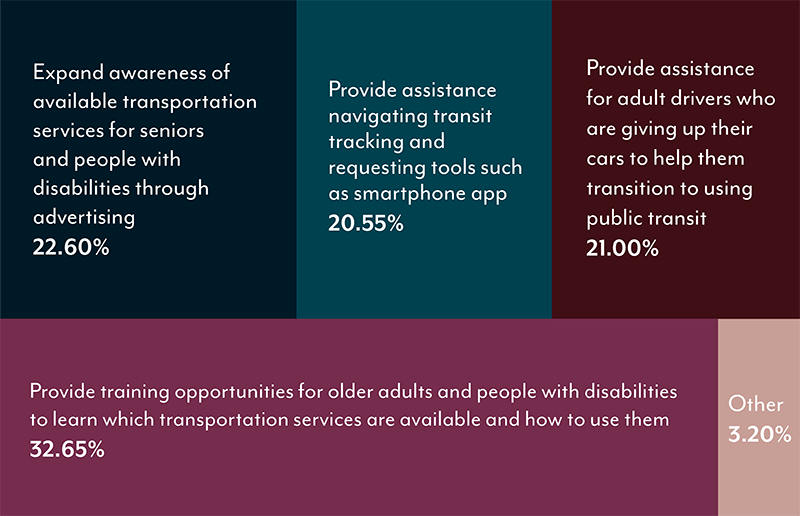
Across the four categories, the four most commonly selected strategies were
Respondents were asked to rank their selected strategies from highest to lowest priority. The two most frequently selected strategies from each category are shown in Figure 4-6—the darkest blue indicates when a strategy was most frequently ranked in that category.
Figure 4-6
Ranking of Strategies to Improve Human Services Transportation

Respondents consistently ranked improving accessibility and comfort at transit stations and stops as their top priority, with 47 percent of respondents indicating this as their top priority. Figure 4-7 shows the self-reported zip code of survey respondents who indicated access and comfort as their top priority. Trends show that access and comfort is particularly notable in municipalities near the Inner Core that are along commuter rail lines. There are minimal geographic trends that arise from the remaining priority areas. Improvements to ensure sidewalk and street crossings comply with the Americans with Disabilities Act of 1990, expanding existing transit service schedules throughout the day and on weekends, and providing new services for municipalities with limited to no transit service were frequently noted as other top priorities. While some people indicated that advertising and education are important strategies, these strategies were ranked low compared to infrastructure and public transportation improvements.
Figure 4-7
Zip Code of Respondents with “Improve Access and Comfort” as Top Priority

This section summarizes the transportation needs of seniors and people with disabilities identified through public engagement efforts, in addition to strategies and actions that were identified to address those needs. They were grouped into the following topic areas:
Table 4-2 shows the needs, strategies, actions, and resources to support them by topic area.
Table 4-2
Unmet Human Service Transportation Needs and Strategies for Improvement
Feedback Source |
Engagement Focus |
Time |
Human Services Transportation survey |
Coordinated Plan |
Spring–Summer 2023 |
Human Services Transportation Coordination Workshop |
Coordinated Plan |
April 2023 |
RCC meetings |
Coordinated Plan |
Summer 2022 and 2023 |
Transit Working Group Coffee Chats |
Coordinated Plan |
October 2021 and November 2022 |
Regional Advisory Council meetings |
Coordinated Plan; general human services transportation coordination |
January 2023 and June 2023 |
MAPC subregional group meetings |
LRTP Needs Assessment; TIP; and other MPO programs and projects |
Fall 2020, 2021, and 2022 |
Other Transit Working Group meetings |
General transit service issues and priorities |
2021–22 |
Other RCC meetings |
General transit service and transportation issues and priorities |
2021–22 |
UPWP study idea surveys |
UPWP |
2020–23 |
TIP criteria update engagement |
TIP |
2019 |
Big Ideas for Scenario Planning focus groups |
LRTP |
2021 |
Destination 2050 visioning survey |
LRTP |
2022–23 |
Community Health Needs Assessments from regional medical institutions |
Coordinated Plan |
2019–23 |
ADA = Americans with Disabilities Act. COA = councils on aging. LEP = limited English proficiency. RTA = regional transit agency. TNC = transportation network company.
1 While funding of benches and shelters are allowed under federal 5310 guidelines, as a practice, it is not part of the state Community Transit Grant Program. Other funding opportunities that may support these are listed in table 4-3 or may seek support from their regional transit authority.
There is a wide variety of unmet transportation needs for seniors and people with disabilities. Funding is limited, and therefore it’s necessary to prioritize investments thoughtfully. This Coordinated Plan does not attempt to dictate which strategies and actions should receive funding. Rather, it describes priorities for the Boston region based on how frequently needs were identified during the public engagement process as a way for transportation providers to develop Community Transit Grant Program (CTGP) applications. Public feedback indicated an ongoing need to improve infrastructure and general operations of human service transportation, while also improving the customer experience.
Figure 4-7 shows distribution of comment topics submitted to MPO staff. More than one-half of all comments received spoke of transportation service improvements, with the next most common topic areas being infrastructure improvements and inter-agency coordination.
Figure 4-8
Public Engagement Comment Topic Area

The priorities listed below could help improve the coordination and implementation of transportation services for seniors and people with disabilities in a cost-effective manner, while expanding transportation options.
There are many resources in the Boston region that can help transportation providers implement these strategies. Table 4-3 presents a list of some of the state and federal funding sources available from the Massachusetts Department of Transportation, the MPO, and MAPC that could support the implementation of the strategies and actions listed in this chapter, in addition to the CTGP. Although not a comprehensive list, it provides a resource for transportation providers, municipalities, and nonprofit organizations. Some sources provide funding directly for capital, operating, and/or mobility management costs, while others provide technical assistance for the development of project ideas.
Table 4-3
Funding Resources
Agency |
Funding Source |
Description |
Type of Resource |
MassDOT |
Massachusetts’ Section 5310 Program funding. Provides funding for capital and operating expenses and mobility management to improve mobility for seniors and people with disabilities. |
Project implementation |
|
MassDOT |
ADA Retrofits |
ADA Retrofits is an investment from MassDOT’s CIP. Municipalities can initiate projects through their Highway District Office. |
Project implementation |
Boston Region MPO |
Provides funding for transportation infrastructure projects. A portion of total available funding is reserved each year for the Community Connections investment program. Eligible projects include
|
Project implementation |
|
Boston Region MPO and MAPC |
Provides municipal officials with technical advice on local transportation concerns, including safety, bicycle and pedestrian access, parking, and roadway redesign |
Technical assistance |
|
Boston Region MPO |
Provides RTAs, TMAs, and municipalities with assistance to address transit issues related to route planning, ridership, cost effectiveness, and other service characteristics |
Technical assistance |
|
MAPC |
Provides technical assistance to address local parking management, mobility studies, procurement, and Complete Streets Prioritizations, including bike and pedestrian plans |
Technical assistance |
|
MAPC |
Provides assistance with funding opportunities that enable and assist cities and towns in implementing projects that are beneficial to the community |
Technical assistance |
ADA = Americas with Disabilities Act. CIP = Capital Investment Program. MAPC = Metropolitan Area Planning Council. MassDOT = Massachusetts Department of Transportation. MPO = metropolitan planning organization. RTA = regional transit agency. SOV = single-occupancy vehicle. TMA = transportation management association.
The Coordinated Plan provides information about existing transportation options in the region, transportation needs of seniors and people with disabilities, and strategies to address these needs and support applications for Federal Transit Administration’s Section 5310 program, known in Massachusetts as the Community Transit Grant Program (CTGP). Overall, the public engagement undertaken to support the development of the Coordinated Plan highlighted a need for improved coordination of transit services to expand service for seniors and people with disabilities, especially as the population of the region ages, as well as reducing redundant services in the region and improving transportation infrastructure as key priorities.
This 2023 update to the Coordinated Plan replaces the Boston Region Metropolitan Planning Organization’s (MPO) 2019 Coordinated Plan starting with the state fiscal year 2025 CTGP grant cycle. This document will be updated again in four years in concert with the Boston MPO’s next planned Long-Range Transportation Plan update, per federal guidance.
Appendix A—Coordinated Plan Survey Instrument